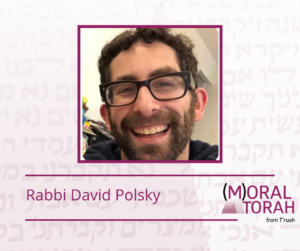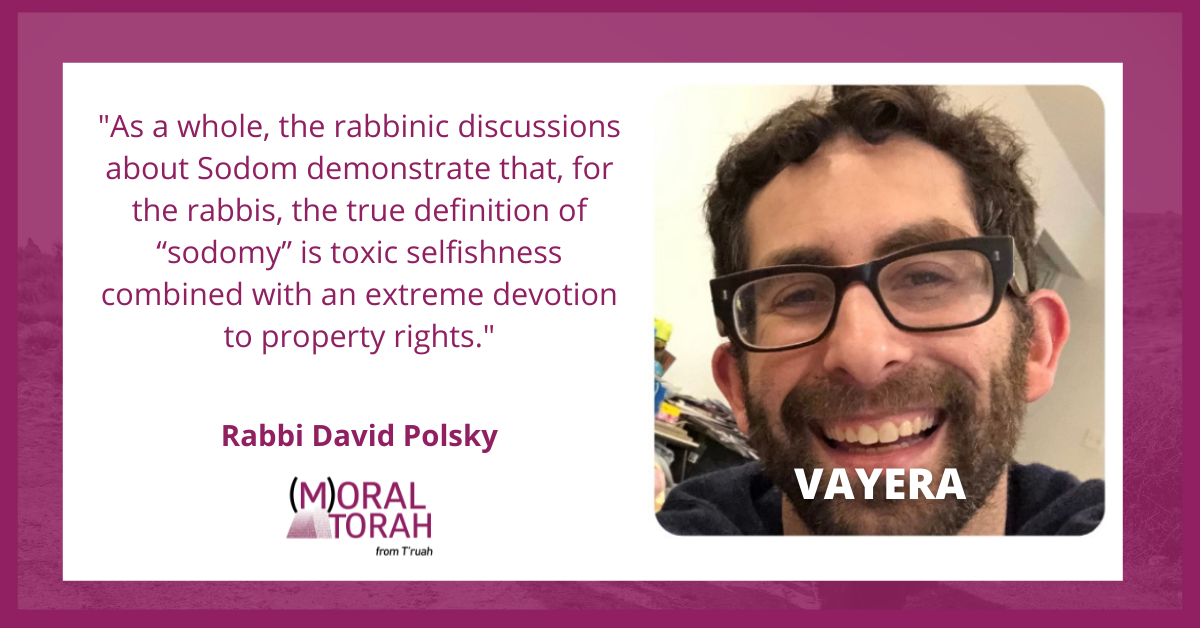A D’var Torah for Parshat Vayera by Rabbi David Polsky
On June 9th, 2021, the Waukesha, Wisconsin, school board voted to opt out of a federally funded school lunch program for all students, regardless of family income, with one board member justifying her vote by saying the free program would lead families to “become spoiled.” Their desire to prevent poor students from receiving free meals — even at no extra cost to the school board — is a perfect example of what the term “sodomy” meant to the talmudic sages. (On August 30 the board reversed its decision.) Although, in English, “sodomy” is used to describe a sex act, the rabbinic sages understood the wicked city of Sodom (destroyed in this week’s parshah) through the prism of extreme selfishness.
The sages draw out the image of the selfish city with legends of their avarice. In their telling, God blesses the city with great wealth. Instead of deigning to share it with others, they decide to prohibit any help to foreigners, as that would only drain their resources (Sanhedrin 109a). Sodom soon extends their distaste for charity to all those in need and proclaims that “anyone who gives bread to the poor will be burned in fire” (Pirkei DeRabbi Eliezer 25). Pelotit, the daughter of Lot, takes compassion on a poor man, secretly feeding him. When she is caught and sentenced to death, her cry rises to Heaven, prompting God to destroy Sodom (ibid.).
Sign up to receive (M)oral Torah in your inbox each week.
The talmudic sages refer to this avaristic mentality of Sodom as “Middat Sedom,” the character trait of Sodom, in a moral teaching about property. Pirkei Avot 5:10 presents four typologies of people’s relationships with their property and that of others. The mishnah begins: “One that says: ‘mine is mine, and yours is yours’ — this is a commonplace type; and some say this is the character-trait of Sodom.”
Commentators on the Mishnah try to figure out whether this “and some say” is a dispute or a clarification. If it is Middat Sedom, how can the Mishnah first say that it is normal? I believe that the first opinion in the Mishnah is noting that, in moderate form, the attitude of “mine is mine and yours is yours” is natural. However, the second opinion is concerned that such an attitude towards property when taken to extremes can reveal itself as Middat Sedom.
So abhorrent is Middat Sedom to the rabbis that they curtail legal and property rights to prevent its manifestation — in talmudic language, “Kofin al middat sedom” (we use the force of law to compel one against acting like a Sodomite).
According to Rashi, this legal principle is exemplified by the Talmud’s discussion of someone squatting on another’s property. Since the owner never rents out the space to others, the owner does not actually lose anything because of the squatter, while the squatter gains from not having to pay rent (Bava Kamma 20a). The owner’s refusal to allow anyone else to enjoy their property for free shows that they are acting like a Sodomite. (The case of the squatter is eerily reminiscent of Washington D.C. recently tearing down homeless encampments in the NoMa neighborhood.) As Rabbeinu Asher (“The Rosh,” 13th century France/Spain) puts it, “We force them to distance themselves from evil traits and to act with generosity towards their fellow when they would not lose anything by doing so” (Teshuvot HaRosh 97:2).
Commentary by Rabbi Jacob Joshua Falk (18th century Poland/Germany) illustrates that these compulsions against sodomy limit property rights. He explains that, really, whether or not an owner loses is much less significant than another person gaining from them. The very fact that the squatter benefits from the owner’s property would be enough to generate an obligation to pay, whether or not the owner suffers a loss because of it. However, he explains, not wanting to help others even when we don’t lose anything from it is a Sodomite tendency. We therefore constrain the owner’s typical legal rights so as not to reinforce their sodomy (Penei Yehoshua Bava Kamma 20a).
Find more commentaries on Vayera.
In stark contrast to the Sodomite view of property rights as sacrosanct, the rabbinic principle of Kofin al middat Sedom suggests that halakhah views property rights as merely contingent. In the words of the modern day Rosh Yeshiva Rabbi Aharon Lichtenstein, “Kofin al middat Sedom absolutely contradicts the prevailing notion that a person is the supreme ruler over [their] property…and that as long as [they do] not cause others direct damage, [they] can do with [their] property as [they please]…” Instead, R. Lichtenstein argues, property rights are “liable to be set aside in the face of other moral factors – including the welfare of others.”
 As a whole, the rabbinic discussions about Sodom demonstrate that, for the rabbis, the true definition of “sodomy” is toxic selfishness combined with an extreme devotion to property rights. Their conversations and legal rulings in opposition to “sodomy” can serve as an invitation for us to re-evaluate our relationship to property and to balance it with our moral responsibility to help others.
As a whole, the rabbinic discussions about Sodom demonstrate that, for the rabbis, the true definition of “sodomy” is toxic selfishness combined with an extreme devotion to property rights. Their conversations and legal rulings in opposition to “sodomy” can serve as an invitation for us to re-evaluate our relationship to property and to balance it with our moral responsibility to help others.
Rabbi David Polsky is a rabbi, educator, and Kashrut professional living in the Metropolitan Detroit area with his wife and two girls. Before moving to Michigan in 2016, he served as the rabbi of Congregation Anshe Sfard of New Orleans for five years. Rabbi Polsky received his semikhah from Yeshiva University. He recently published a series of articles making a halakhic case for police accountability. Currently, he is writing a Jewish mindfulness and wellness curriculum for elementary school students. He tweets as @MotownRabbi.

